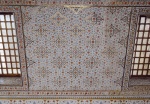Last weekend, we delivered our daughter Isla (and all her belongings!) to London ready to start a new job and we took the chance to visit some of our favourite museums. I love visiting museums, especially ones that I’m very familiar with, as I always get to revisit objects that are old favourites and always discover some new ones. In a familiar museum you don’t have the pressure to visit every inch on display, but instead can take the time to take in the objects that really catch your eye.
Here are some photographs of favourite things to be found in the Victoria & Albert Museum and the British Museum. Alex and I snapped things that took our eye as we were walking round and spent a lot of time in the Chinese collections, so the mix is a bit idiosyncratic but you’ll hopefully find it interesting!

The V&A building itself, with its eccentric mix of Victorian red brick and classical design, always delights me.

The South-Asian section of the V&A has some marvellous carved sandstone window screens.

Regulars will know that I love old doors. Here is an English one in the V&A

Alex loves the clean iconic forms and translucent surfaces of ancient Chinese jade ritual blades (V&A)

We both love the patina on ancient Chinese bronzes (British Museum)

Alex thinks that some of my work reminds him of the shapes found decorating ancient Chinese bronze vessels? (British Museum)

I love this little chap! Chinese bronze (British Museum)

Abstract art from 2,000 years ago? Chinese jade object (British Museum)
The experience of visiting the major London museums is changing, as quite a few now offer free wi-fi, allowing you to use your phone or iPod to search for instant information on the objects you are looking at. This advance made our visit much more interesting and accessible, as we looked up everything from indigo to Equus. Visit a museum again soon!




































































































































